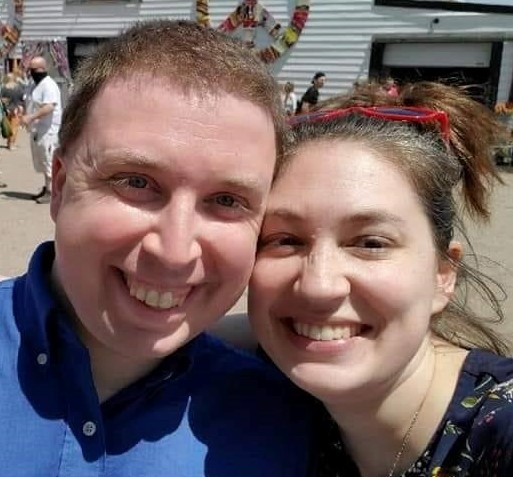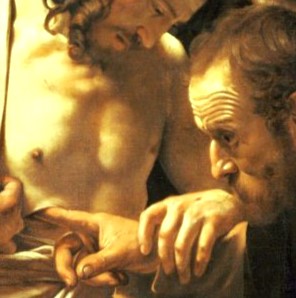By Deacon Timothy Siburg*
Revised Common Lectionary
Reflection, Second Sunday after Easter, Year A
Click here
for the lessons
April 16, 2023
Key verse: But these are written so that you may come to believe that Jesus is the Messiah, the Son of God, and that through believing you may have life in his name. -John 20:31
On this side of the Resurrection, the story of what God in Christ has done is starting to spread. But not even all of Jesus’ own disciples know what to make of it. Nor do they even all believe it to be true and real.
This week we revisit the story we hear each year on the Second Sunday of Easter about Jesus and the Apostle Thomas. In this account from John 20, Thomas famously says, “Unless I see the mark of the nails in his hands, and put my finger in the mark of the nails and my hand in his side, I will not believe.” Even in his defiance to believe in the resurrection unless his stipulations are met, Jesus shows up and meets him where he is at.
But this isn’t solely a story about Thomas. It’s a story about discipleship. But it’s also, perhaps most importantly, a story about Jesus’ love, which invites us to respond through our belief and act as stewards of God’s love. In this story we see the work of the resurrection from a week ago continue. We also see that:
- God’s promises are true, as Thomas will come to see and believe.
- Jesus meets us where we are personally. No matter how little or how much we might believe. No matter what ups or downs of life we might be facing. Jesus, the Good Shepherd, knows all of Jesus’ sheep and comes alongside each and every one of us.
- Jesus comes and meets us where we are at contextually. Whether we are in a locked room out of fear and uncertainty. Whether we’re gathered with other believers through the breaking of bread and the drinking of wine or sharing of the Word. Whether we are alone or gathered together with other disciples. Or even whether we are out along the road while walking on the way to Emmaus, looking for water at the height of the noon day at a well. Jesus comes alongside God’s beloved and meets us where we are at, no matter what situation we might find ourselves in.
- Jesus comes bearing peace – to comfort, welcome, challenge, uplift, sustain, and to gather and send God’s people and all disciples.
- There is work to be done. The work of the stone rolling away has finished. But now the work shifts to tell the story, to proclaim the Good News, to share, and in turn to respond through belief.
This week’s familiar gospel story invites us to reflect on how stewardship is a response. It’s a response to the gift and promise of peace that Jesus brings. And it’s a response and reaction to having belief. Specifically, to the belief that we each have as we come to terms with what God in Christ has done, will do, and promises to do for each one of us.
The Second Sunday of Easter is a fitting time to dig into this because we have a story about Jesus coming near to the disciples and to Thomas, and one about Jesus’ helping the disciples connect the dots with the greater “why” behind all that Jesus has been doing through his life, death, and now resurrection. He’s inviting each of them to make meaning of what they have experienced. And he’s nearing the point where he is about to hand over the responsibility to what comes to next to those same disciples. But first he wants to hear them clearly articulate their own belief.
Everything that follows from here, one might say, is all about stewardship, as Clarence Stoughton once said, “Stewardship is everything we do after we say, ‘I believe.’” As the disciples will soon lead, share, and serve as stewards of God’s love, so do we.
Further Questions for Reflection and Preaching
- What do our beliefs have to do with our work as stewards?
- How does belief connect to our vocation?
- What are the particular needs of your neighbors in your context, and what might God in Christ be inviting us to see, be, and do as disciples and stewards on this side of the resurrection in your local area?
In Worship
The last time we were in Year A during the Easter season it 2020, at the height of the pandemic. That year brought the first full liturgical season that we experienced completely virtual, in most cases. As we approach these stories again in worship this year, perhaps invite responses from the congregation (both for those who might be gathered in-person and online). What are their fears and longings? What questions are they holding tightly now that only Jesus might be able to help open and surface? Where have they seen or experienced Jesus meeting them where they are at, recently?
As my friend the late Rev. Sharron Blezard shared three years ago, I want repeat this notion, too, for something entirely different: “Some folks may be celebrating this as Holy Humor Sunday. If you go that route, invite worshipers to dress silly for worship and to share their favorite jokes or puns.” Jesus’ appearance to the disciples might seem like a joke at first. But with the benefit of the bigger story, we know better. And with Jesus, we do have the ability to laugh, for death does not have the last word.
Worship with Youth
In the worship setting in which I most commonly find myself, we have a long-standing practice of an extra layer of celebration and joy during the closing hymn or worship song. This can look and feel like a lot of different things. But it usually involves having acolytes distribute different rhythm or shaker instruments for the final hymn and having the congregation sing, play, and even dance – sometimes together with an extra layer of joy and movement as we transition from the worship experience to a time of fellowship afterwards, and from there to the work of our daily week. This is often most effective in my context when congregational youth help lead it– by distributing the instruments, taking joy in setting the rhythm alongside the musicians (which is often me on piano), and just giving each other permission to go as the Spirit invites. Given the themes of this week’s stories, hymns that could be particularly fun that might fit this feel include: “Hallelujah! We Sing Your Praises,” or the spiritual, “I’m So Glad Jesus Lifted Me.”
Worship with Children
For teaching during a Sunday School or Children’s Church Time, or as interactive experience during a Children’s Message in worship, consider a way to make tangible the actions of Thomas touching Jesus in a way that doesn’t violate any boundaries. This may be harder to do than you might think. But here’s a possibility: Find something that is meaningful in your context but small enough to fit in a box or closed container that one can’t see but has a hole large enough for a child to put their hand. Invite children to take turns feeling the object through the hole in the box. Ask them to share what it feels like. What kind of shape does it have? What kind of texture? What does it remind them of, if anything? What do they think it might be? Once all children that have a desire to touch the object have had a chance to do so (or at whatever point it might be time to move on), reveal what the object is to them and to the whole congregation. Connect this experience in some way to Thomas trying to make sense of Jesus’ presence. Close with a repeat after me prayer like one that follows:
Dear God (Dear God),
Thank you for today (thank you for today),
Thank you for your love (thank you for your love),
And thank you for Jesus (and thank you for Jesus),
Who is with us always (who is with us always).
Help us to remember (help us to remember),
Jesus’ love for us (Jesus’ love for us),
And to share that love (and to share that love),
With everyone (with everyone),
In your name we pray (in your name we pray),
Amen (Amen).
Previous reflections for Easter 2A
2020 – Resurection … to be continued
2017 – Beyond Unbelief: An Evangelism Lesson from Thomas
2014 – Life in his name

Timothy and Allison Siburg
About the Author
Deacon Timothy Siburg serves as the Director for Mission, Innovation, and Stewardship of the Nebraska Synod, ELCA, as well as the bishop’s designate as the synod’s Director for Evangelical Mission. He also currently serves on the Stewardship of Life Institute Board and has previously written and worked for the Ecumenical Stewardship Center. When not out and about the Nebraska Synod on a given Sunday, he can be found at home at Salem Lutheran Church in Fontanelle, Nebraska serving as organist, pianist, and choir director and serving alongside his wife, the Rev. Allison Siburg in leading worship. Together they have two young daughters who fill life with joy, humor, and constant surprises.




Leave a Reply